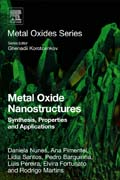
Metal Oxide Nanostructures: Synthesis, Properties and Applications
Santos, Lídia
Gomes, Daniela
Pimentel, Ana
Barquinha, Pedro
Pereira Coutinho, Luís
Fortunato, Elvira
Martins, Rodrigo
Metal oxides benefit from the large electronegativity of the oxygen to induce strong electron bonding with the nearby atoms, which determine the unique chemical and surface properties of these materials. The growing demand for materials and devices with new functionalities has led to an increased interest in the field of nanomaterials and nanotechnologies. In general, nanostructured materials profit from the spatial con?nement along with the large fraction of surface atoms, high surface energy, strong surface adsorption and increased surface-to-volume ratio. Nanostructured metal oxides appear to be a good alternative to a plethora of applications, away from the conventional covalent based materials. This book will be devoted to give the readers an overview of all the important topics related with oxide nanostructures, from physics of the materials to its application. It will cover theoretical and experimental aspects related with design, synthesis, fabrication, processing, structural, morphological, optical and electronic properties (Chapters 1-3), ending with its application as chromogenic, electronic, sensing and catalyst materials (Chapters 4-6). A review on surface functionalization and hybrid materials will also be discussed (Chapter 7), focusing on the advantages of these oxide nanostructures. The book concludes with the current and future prospect applications of these materials. Only book to delve into hybrid structured metal oxides which present promising candidates for the next generation of electronic devicesIncludes fundamental chapters on synthesis design, and properties of metal oxide nanostructuresProvides an in-depth overview of novel applications including chromogenic, electronic and energy INDICE: 1. Introduction 2. Synthesis and design of metal oxide nanostructures 3. Structural, morphological, optical and electronic properties of the nanostructures 4. Chromogenic applications 5. Electronic and sensing applications. Of sensors with interesting performances 6. Energy applications 7. Hybrid structures and surface functionalization 8. Future perspectives
- ISBN: 978-0-12-811512-1
- Editorial: Elsevier
- Encuadernacion: Rústica
- Páginas: 475
- Fecha Publicación: 01/05/2018
- Nº Volúmenes: 1
- Idioma: Inglés
